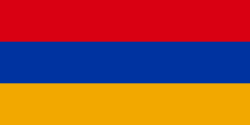Portal:Europe/Selected article/1
The national flag of Armenia consists of three horizontal bands of equal width: an upper band of red, blue in the middle, and a lower band of orange. The Armenian Supreme Soviet adopted the current flag on 24 August 1990. On 15 June 2006, the Law on the National Flag of Armenia, governing its usage, was passed by the National Assembly of Armenia.
Throughout history, there have been many variations of the Armenian flag. In ancient times, Armenian dynasties were represented by different symbolic animals displayed on their flags. In the twentieth century, various Soviet flags represented the Armenian nation. The meanings of the colours have been interpreted in many different ways. For example, red has stood for the blood shed by Armenian soldiers in war, blue for the Armenian sky, and orange represents the fertile lands of Armenia and the workers who work them.
Today's tricolour flag bears little resemblance to the earliest Armenian 'flags'; in ancient times, armies went into battle behind carvings mounted on poles. The carvings might represent a dragon, an eagle, a lion or 'some mysterious object of the gods'. With the advent of Christianity, the Armenian empire adopted many different flags representing various dynasties. The Artaxiad Dynasty's flag, for instance, consisted of a red cloth displaying two eagles gazing at each other, separated by a flower.

